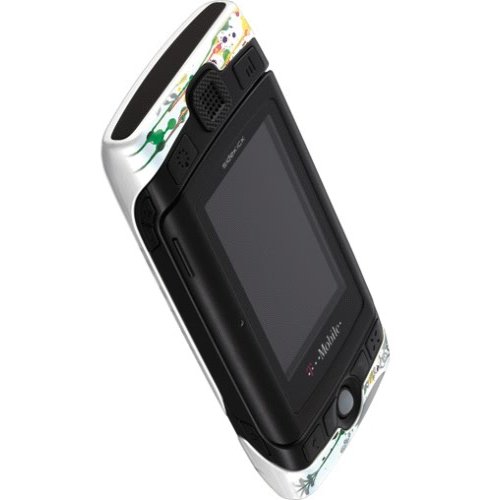

The Hiptop line is designed to be held horizontally with both hands, allowing typing with two thumbs, similar to a Game Boy Advance or a console video game controller. The bottom has volume controls and a power button. The top of the unit has two application-specific shoulder buttons. The right side also has two phone buttons: send call (also page-down) and end call (also page-up). On all Hiptops except the original, the left side houses a directional pad and on the right, a track ball (excluding the original Hiptop) The Hiptop 2 and Slide's directional pad contains internal multicolored LEDs used in ringers and notifications, while the 3, 2008, LX, and 2009 track ball contains internal multicolored LEDs that provide the same function. There are two buttons on the left side of the device ("menu" and "jump") and also two on the right ("back" and "cancel"). Screens on all Sidekick devices (excluding the Slide and 4G models) slide vertically to

and has been considered to be iconic in the mobile devices market. The Hiptop/Sidekick became incredibly popular in the U.S. All versions of the Hiptop were developed in close partnership with T-Mobile, although carrier-specific features were either removed or added for each carrier, such as the addition of MMS for SunCom and Telstra Hiptop 2 users, where the feature was not available on T-Mobile USA devices until the Sidekick LX in 2007. The Hiptop II, 3, Sidekick iD, Sidekick 2008 and Sidekick LX (2009) are all manufactured by Sharp Corporation in Japan and designed, respectively, by Danger and then Danger in partnership with Sharp. The original Hiptop hardware was designed by Danger and manufactured by Flextronics.
Tmobile sidekick cheap software#
This included a catalog of downloadable software applications, email hosting, instant messaging, web proxies and a cloud service for the entire personal data on the device. Danger provided the Hiptop OS software and back-end services for the device. The Hiptop software was designed by Danger, Inc., which was located in Palo Alto, California, and purchased by Microsoft for $500 million in 2008. The Danger Hiptop, also re-branded as the T-Mobile Sidekick, Mobiflip and Sharp Jump is a GPRS/ EDGE/ UMTS smartphone that was produced by Danger, Inc. But when it does return, you'd better believe it'll have a real OS behind it.The original Hiptop with revised color screenĭanger Incorporated / Flextronics / Sharp Corporation / Motorola / SamsungĢ002–2010 (Sidekick Web Services to 2011)Ĭolor (Monochrome for the 1st gen Sidekick/Hiptop)Īttachable 0.3 Megapixel (Built in for later models) It's still a strong brand even if the products are obsolete.

"Will Sidekick come back ever? Sure, probably. "n this world of hyper-capable smartphones, there's really no place for a device that costs as much and can't do nearly enough," Barrett writes. Over at Gizmodo, Brian Barrett ponders the future of the Sidekick. The phone originally won raves for its fast, intuitive sliding keyboard, but as the market became saturated with handsets such as the iPhone 4 and the Motorola Droid X – phones with operating systems and software that well outpace the OS on T-Mobile's text-happy machine – Sidekick sales have slumped. "T-Mobile looks to further innovate and raise the bar for the next iteration of the T-Mobile Sidekick, as of July 2, the Sidekick LX and Sidekick 2008 will no longer be available through T-Mobile, including retail stores, care, telesales and online," the T-Mobile statement said.Ģ010 has been a slow year for the Sidekick. It's hard out there for a (non- Apple, non- Android) phone.ĭays after Microsoft took the short-lived Kin out of commission – amid rumors that only 500 Kin units had been sold – T-Mobile has pulled the plug on the Sidekick, a handset eulogized by Gizmodo as "the granddaddy of messaging phones." T-Mobile said in a statement that it is looking forward to the "the next chapter of our storied Sidekick franchise," and told current Sidekick owners that their service would remain unaffected.


 0 kommentar(er)
0 kommentar(er)
